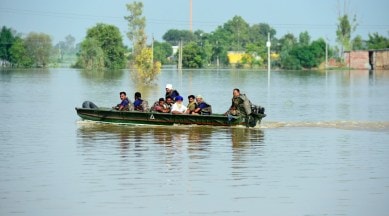Stay updated with the latest - Click here to follow us on Instagram
As floods wreak havoc Punjab farmers suffer losses: ‘Who will compensate us?’
June-July, in particular, witnessed heavy rains and flooding across over 2.4 lakh hectares in the state where farmers had already planted paddy

While large parts of India have seen dry weather, Punjab has experienced quite the opposite. June-July, in particular, witnessed heavy rains and flooding across over 2.4 lakh hectares in the state where farmers had already planted paddy. Even as the waters eventually receded, the paddy plants in nearly 86,500 hectares couldn’t survive the continuous inundation. The farmers here were then left with two options: Write off this kharif season or re-transplant the crop, entailing spending the same money all over again. The Indian Express profiles two farmers who chose the latter and one the former.
Balbir Singh: Sheikh Manga village, Sultanpur Lodhi tehsil, Kapurthala district
monthly limit of free stories.
with an Express account.
The 35-year-old completed the transplanting of Supreme-110, a hybrid paddy, on 13 acres (six own and seven taken on lease at Rs 50,000 per acre) by mid-June. Almost a month later, the floods from heavy rain and embankment breaches had submerged all his fields under 8-10 feet of water.
Towards July-end, he managed to pump out the water from five acres, while the remaining eight continue to remain under water. On this five acres, he re-transplanted PR-126, a short-duration paddy variety, during the second week of August.
Balbir says he spent around Rs 8,000 per acre on his first crop: Rs 1,500 for seed and nursery sowing, Rs 1,500 for pre-transplanting puddling and field preparation, Rs 4,000 for labour to transplant the seedlings and Rs 1,000 for urea and other fertilisers. That added up to Rs 1.04 lakh, in addition to the Rs 3.5 lakh lease rent on seven acres. A month later, he would spend another Rs 40,000 to replant on five acres, even while the remaining eight acres remains under 6-7 feet and uncultivable.
“Who will compensate me for my loss? Also, I would have harvested about 35 quintals per acre from Supreme-110, whereas the PR-126 transplanted so late will give me 26-28 quintals at best,” says this farmer, who is investing all his hopes on the next rabi season wheat crop.
Daljit Singh: Gatti Raipur village, Shahkot tehsil, Jalandhar district
This 71-year-old farms 40 acres, 20 of his own and the rest leased at Rs 55,000/acre. The entire 40 acres, along with the 20-25-day-old transplanted paddy on them, were submerged by the floods on July 11. It included 20 acres next to a bund near the Sutlej river that burst. The crop on this land suffered total damage after being 5-6 feet under water for two weeks.
Daljit, however, managed to salvage the paddy on the remaining 20 acres that were farther away by erecting temporary mud embankments before the water levels rose. On the damaged crop land, he had to undertake re-transplanting around August 5.
“I had earlier planted Supreme-110 and basmati varieties such as Pusa-1847 and 1692, now fetching Rs 1,000-1,500/quintal more than the minimum support price (of Rs 2,203 for ordinary paddy). Now, I have been forced to plant PR-126 that yields less,” complained Daljit, who is also sarpanch (head) of his village. He estimated his own losses, on account of additional re-transplanting expenses and revenues forgone from lower value-cum-yield paddy, at Rs 40,000-45,000 per acre. Like Balbir, he wasn’t sure how much of this would be compensated by the government.
Mahinder Singh: Gatta Mundi Kasu village, Shahkot, Jalandhar
On the fateful night of July 11-12, the 52-year-old’s five-acre farmland as well as house were engulfed by flood waters that are 10-12 feet deep. Mahinder had, only three weeks earlier, transplanted paddy on his land. More than 50 days after the floods, the water levels in his field are still at 2-3 feet.
“I spent around Rs. 40,000 in all then. With my land still under water, it is not possible to do any puddling (wet-tilling) or field preparation. So, re-transplanting is ruled out,” lamented Mahinder, who has just returned home after a month’s displacement and forced stay at a relative’s place that did not suffer inundation.
The challenges don’t end there. The floods also brought in 4-5 feet of sand into his fields through the river’s course, which makes sowing of the next wheat or potato crop practically impossible. Restoring the land to its original cultivable status would require investing substantial money. “I cannot afford that,” said Mahinder, who is now reconciled to engaging in manual labour: “What option do I have? Can the government help me to become a farmer again?